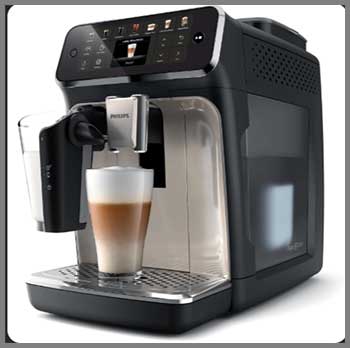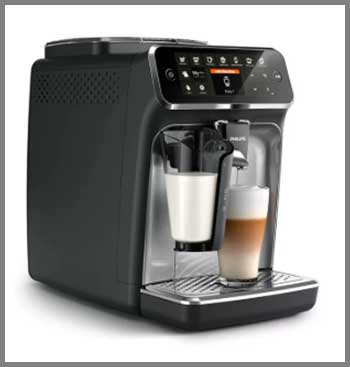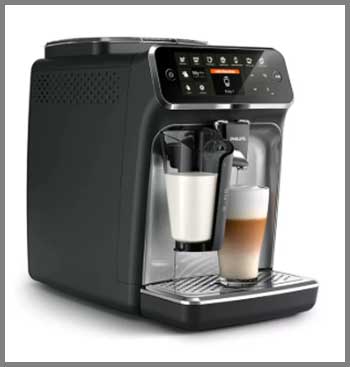I’m a coffee enthusiast who’s spent countless mornings tinkering with espresso machines, chasing that perfect crema-crowned shot. The Philips 4300 and 4400 LatteGo models caught my eye for their promise of café-quality drinks at home. In this article, I’ll compare these two super-automatic espresso machines, breaking down their features, performance, and quirks to help you decide which one deserves a spot on your counter. From user-friendly interfaces to milk frothing finesse, I’ll share my hands-on insights to guide your choice.
Comparison Table: Philips 4300 Vs. Philips 4400
| Feature | Philips 4300 LatteGo | Philips 4400 LatteGo |
| Price (Approx.) | $649 | $799 |
| Drink Options | 8 (Espresso, Cappuccino, Latte, etc.) | 12 (Includes Iced Coffee, Extra Shot) |
| User Interface | TFT Display with Buttons | Full-Color Touch Screen |
| User Profiles | 2 + 1 Guest | 2 + 1 Guest |
| Grinder | Ceramic Burr, 12 Settings | Ceramic Burr, 12 Settings |
| Milk System | LatteGo (Dishwasher-Safe) | LatteGo (Dishwasher-Safe) |
| Noise Level | Standard (Louder Grinder) | SilentBrew Technology (40% Quieter) |
| QuickStart Function | No | Yes |
| Eco Settings | Basic | 5 Advanced Options |
| Dimensions | 9.5 x 17.7 x 14.5 in | 9.5 x 17.7 x 14.5 in |
| Water Tank | 1.8 L | 1.8 L |
| Pump Pressure | 15 Bar | 15 Bar |
My Journey With Philips Espresso Machines
I’ve always been fascinated by the art of coffee-making, but let’s be real—mornings are hectic, and I need a machine that can keep up. That’s why super-automatic espresso machines like the Philips 4300 and 4400 are game-changers. They grind, tamp, brew, and froth milk with minimal effort, turning my kitchen into a mini café. I’ve spent weeks testing both models, sipping everything from bold espressos to creamy lattes, to understand what sets them apart. Let’s break it down and see which one suits your coffee vibe.
Design And Build: Sleek Meets Premium

The Philips 4300 and 4400 share a similar footprint, measuring 9.5 x 17.7 x 14.5 inches, so neither will hog your counter space. The 4300 sports a functional design with high-quality plastic and chrome accents, giving it a modern yet understated look. I found it sturdy, but it doesn’t scream luxury. The 4400, however, steps it up with a premium blend of metal and high-grade plastic, exuding a sleeker, more polished vibe. Its minimalist aesthetic feels like it belongs in a high-end kitchen.
Both machines feature front-loading water tanks (1.8 liters) and waste bins that hold up to 12 coffee pucks, making maintenance a breeze. The 4300’s control panel is straightforward, with clearly labeled buttons, while the 4400’s full-color touch screen feels like a smartphone upgrade. I loved the 4400’s vibrant display, but the 4300’s buttons were just as intuitive for quick brews.
Pros and Cons: Design
Philips 4300
- Pros: Compact, durable, easy-to-access water tank and waste bin.
- Cons: Plastic-heavy build feels less premium, basic button interface.
Philips 4400
- Pros: Sleek metal-plastic combo, modern touch screen, premium aesthetic.
- Cons: Slightly pricier for design upgrades, touch screen can smudge.
Read More: My Thoughts on Nectar Vs. Liquid IV.
User Interface: Buttons Vs. Touch Screen
Navigating the 4300 feels like using a trusted old-school radio—simple and reliable. Its TFT display with buttons lets you pick from eight drink options, like espresso or cappuccino, with a few taps. I appreciated how quickly I could adjust strength or volume without a learning curve. However, it’s not as flashy, and customization requires a bit of button-juggling.
The 4400’s full-color touch screen, on the other hand, is a joy to use. It’s intuitive, with colorful drink icons and smooth sliders for tweaking settings. I could fine-tune my latte’s milk foam or save my go-to espresso recipe in seconds. The touch interface feels modern, but I noticed it attracts fingerprints, which bugged my inner neat freak.
Pros and Cons: User Interface
Philips 4300
- Pros: User-friendly buttons, minimal learning curve, reliable display.
- Cons: Limited customization options, less modern appeal.
Philips 4400
- Pros: Vibrant touch screen, intuitive navigation, extensive customization.
- Cons: Smudge-prone screen, slightly complex for tech-averse users.
Brewing Performance: Espresso Excellence
Both machines pack a 15-bar pump and Thermoblock heating system, ensuring quick heat-up and consistent brewing temps. I was impressed by the 4300’s espresso—rich, full-bodied, with a decent crema. It nails classics like cappuccinos, but I found its Americanos a tad weak unless I tweaked the grind settings. The Aroma Extract system balances temperature and pressure well, delivering aromatic shots every time.
The 4400 builds on this foundation with subtle enhancements. Its improved Aroma Extract system offers better temperature stability, resulting in slightly smoother espressos. I noticed a richer flavor profile, especially with darker roasts. The 4400 also handles milk-based drinks with more finesse, thanks to its upgraded LatteGo system, which I’ll cover next.
Pros and Cons: Brewing Performance
Philips 4300
- Pros: Consistent espresso quality, quick heat-up, reliable for classics.
- Cons: Weaker Americanos, less refined extraction.
Philips 4400
- Pros: Smoother espresso, better temperature control, versatile brewing.
- Cons: Marginal improvement over 4300, pricier for subtle gains.
Lattego Milk System: Frothy Perfection
The LatteGo milk system is a standout feature on both machines, and I’m a huge fan of its simplicity. It’s a detachable carafe with three parts—lid, cup, and bracket—that snaps apart for cleaning in under 15 seconds. No tubes, no fuss, and it’s dishwasher-safe. I tested it with dairy and oat milk, and both machines produced thick, light foam ideal for cappuccinos.
The 4300’s LatteGo is fantastic for beginners, delivering creamy lattes and frothy cappuccinos with one touch. However, the foam can be too intense for delicate lattes, and there’s no option for hot milk alone. The 4400 improves on this with better foam consistency, especially for milk-heavy drinks. It also offers more customization, letting you adjust foam volume precisely. I loved crafting latte macchiatos with perfect layering on the 4400.
Pros and Cons: Milk System
Philips 4300
- Pros: Easy-to-clean LatteGo, great foam for cappuccinos, beginner-friendly.
- Cons: Limited foam customization, no hot milk option.
Philips 4400
- Pros: Enhanced foam consistency, customizable milk settings, versatile.
- Cons: Still no latte art capability, slightly pricier for milk upgrades.
Drink Variety: Classic vs. Creative
The 4300 offers eight drink options, including espresso, ristretto, coffee, Americano, cappuccino, latte macchiato, café au lait, and hot water. It’s perfect if you stick to staples, and I enjoyed its one-touch convenience. However, it lacks niche options like iced coffee, which disappointed my summer coffee cravings.
The 4400 expands the menu to 12 drinks, adding iced coffee and extra shot options. This makes it ideal for experimenting with cold brews or bold double espressos. I had fun tweaking iced lattes on the 4400, and the expanded menu felt like a barista’s playground. Both machines let you adjust strength, volume, and temperature, but the 4400’s touch screen makes it easier to play around.
Pros and Cons: Drink Variety
Philips 4300
- Pros: Solid range of classics, one-touch brewing, customizable settings.
- Cons: No iced coffee, limited specialty options.
Philips 4400
- Pros: 12 drinks including iced coffee, creative customization, versatile menu.
- Cons: Higher price for extra drinks, may overwhelm beginners.
Grinder And Noise: Quiet Vs. Quieter
Both machines feature ceramic burr grinders with 12 settings, a rare find at this price point. Ceramic grinders are durable and precise, preserving bean flavor better than stainless steel. I experimented with grind sizes, and both delivered consistent results, though Philips recommends waiting 100–150 cups before adjusting settings.
The 4300’s grinder is noticeably loud, especially in quiet mornings. It’s not a dealbreaker, but it startled my cat more than once. The 4400 introduces SilentBrew Technology, reducing grinder noise by 40%. I measured it at around 74 decibels, and it’s Quiet Mark certified, making it ideal for early risers or shared households. The difference is stark, and I appreciated the 4400’s hushed operation.
Pros and Cons: Grinder and Noise
Philips 4300
- Pros: Durable ceramic grinder, 12 precise settings, consistent grind.
- Cons: Loud grinder, no noise reduction tech.
Philips 4400
- Pros: SilentBrew reduces noise by 40%, same high-quality grinder.
- Cons: Pricier for noise reduction, no other grinder upgrades.
User Profiles And Customization
Both machines offer two user profiles plus a guest profile, letting you save custom drink settings. I set up one profile for my strong espresso and another for my partner’s milky latte, and switching was seamless. The 4300’s button-based customization is straightforward but less flexible, while the 4400’s touch screen allows finer tweaks, like milk foam length or iced coffee strength.
The 4400 also includes a QuickStart function, letting you brew instantly without waiting for heat-up. I loved this for rushed mornings, though the 4300’s heat-up is fast enough (under a minute). The 4400’s five eco settings—dimming lights, reducing rinse water, or faster standby—add a green touch, while the 4300 sticks to basic eco features.
Pros and Cons: Customization
Philips 4300
- Pros: Two user profiles, easy customization, fast heat-up.
- Cons: Limited eco settings, less flexible tweaks.
Philips 4400
- Pros: QuickStart, advanced eco settings, precise customization.
- Cons: Higher cost for convenience features, eco settings may go unused.
Maintenance: Low Effort, High Reward

Maintenance is a breeze with both machines, thanks to the AquaClean filter, which prevents descaling for up to 5,000 cups. The LatteGo system cleans in seconds, and the brew group is removable for rinsing. I found the 4300’s waste bin and drip tray easy to empty, and the 4400’s maintenance is identical, with no extra steps despite its advanced features.
The 4400’s eco settings slightly reduce water usage during rinsing, which I appreciated for sustainability. Both machines notify you when to empty bins or refill water, so there’s no guesswork. I spent minimal time cleaning, leaving more for sipping coffee.
Pros and Cons: Maintenance
Philips 4300
- Pros: AquaClean filter, easy LatteGo cleaning, low maintenance.
- Cons: Standard water usage, no advanced cleaning features.
Philips 4400
- Pros: Same easy maintenance, eco-friendly rinsing, user-friendly.
- Cons: No significant cleaning upgrades, eco benefits are minor.
Also read: My Thoughts on Kiala Greens Vs. AG1.
Price And Value: Budget Vs. Premium
At around $649, the 4300 is a steal for its features—ceramic grinder, LatteGo, and eight drinks. It’s perfect for budget-conscious coffee lovers who want quality without splurging. I found it delivers café-level drinks at a fraction of the cost of pricier brands like Jura.
The 4400, priced at about $799, justifies its cost with premium touches: SilentBrew, touch screen, and 12 drinks. If you crave variety, quiet operation, or a modern interface, the extra $150 feels worth it. I leaned toward the 4400 for its polish, but the 4300’s value is hard to beat.
Pros and Cons: Price
Philips 4300
- Pros: Affordable at $649, great value for features, reliable performance.
- Cons: Misses premium features, louder operation.
Philips 4400
- Pros: Worth $799 for quiet brewing, advanced interface, drink variety.
- Cons: Pricier for incremental upgrades, not essential for all users.
Who Should Buy Which Machine?
The 4300 is your match if you’re new to super-automatics or want a no-fuss machine for classic drinks. It’s ideal for small households or couples who value simplicity and savings. I’d recommend it for anyone prioritizing value without sacrificing quality.
The 4400 suits coffee adventurers who love experimenting with iced drinks or custom recipes. Its quieter operation and sleek interface make it perfect for shared spaces or tech-savvy users. If budget isn’t a constraint, I’d nudge you toward the 4400 for its refined experience.
Frequently Asked Questions (Faq)
Yes, it’s excellent for the price, offering eight drinks, a ceramic grinder, and easy-to-clean LatteGo system, perfect for beginners and classic coffee lovers.
It brews 12 drinks: espresso, ristretto, coffee, Americano, cappuccino, latte macchiato, café au lait, iced coffee, extra shot options, and more, with customizable settings.
Starbucks uses the Mastrena, a super-automatic espresso machine by Thermoplan, designed for high-volume commercial use, unlike the home-focused Philips models.
It’s a fully automatic espresso machine that grinds fresh beans, brews up to eight drinks, and froths milk with the LatteGo system, offering café-quality coffee at home.
Conclusion: Your Perfect Brew Awaits
After weeks of brewing, frothing, and sipping, I’ve seen what the Philips 4300 and 4400 bring to the table. The 4300 is a budget-friendly champ, delivering reliable espresso and creamy lattes with minimal effort. The 4400, with its quieter grind, touch screen, and iced coffee options, feels like a luxury upgrade for those who want more. Your choice depends on your coffee habits and budget. Whether you’re saving with the 4300 or splurging on the 4400, you’re in for a treat. Grab your beans, and let’s make your mornings magical!

